By Justin Cresser
Our club begins the major competitive season in the next 2 to 3 weeks, so we are therefore entering into the pre-season phase of the training year. As you transition from the off to the pre-season, the focus should shift to high-intensity training and developing anaerobic endurance. In addition, more time is needed to focus on match preparation (tactics, team shape, etc.) and less time is devoted to fitness training, so your conditioning exercises need to be as economical as possible.
Today’s exercise is a simple conditioning circuit. It is an exercise that I most frequently use during the pre-season as it is very efficient and demands a high work-rate. Not only does it incorporate agility, acceleration and speed endurance; but the work-to-rest ratio also allows you to develop the anaerobic capacity of your players.
For this exercise, you will need a playing area at least 20 yards long and 30 yards wide. Divide your squad into two equal groups. (The amount of cones and stations you set up will depend on the number of players you have. In this example, we have assumed they are two groups of 5 players each.)
Set up a horizontal row of 6 cones so that each cone is 5 yards apart. This creates 5 channels that are all 5 yards in width. Have each player in one of the groups stand in the middle of each channel so that they are 7 yards behind the row of cones. These players should each have a ball (Figure 1).
Set up another row of 6 cones (each cone 5 yards apart), 7 yards away from the first row so that each cone, except the first, is directly in line with a player standing with a ball. Have the players in the other group line up behind the first cone in the second row as shown below (Figure 1).
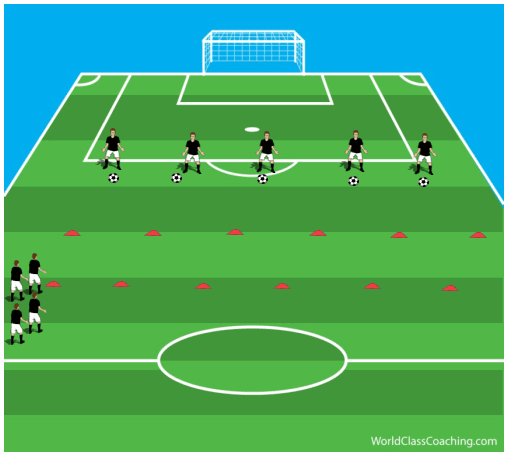
When ready, the player at the front of the line will sprint towards the first channel (space between cones 1 and 2 in the first row of cones) where they will receive a firm pass on the ground that they must return with 2 touches (Figure 2).
(Note: The player should pass the ball so that the sprinting player receives the ball when they are in line with the cones)
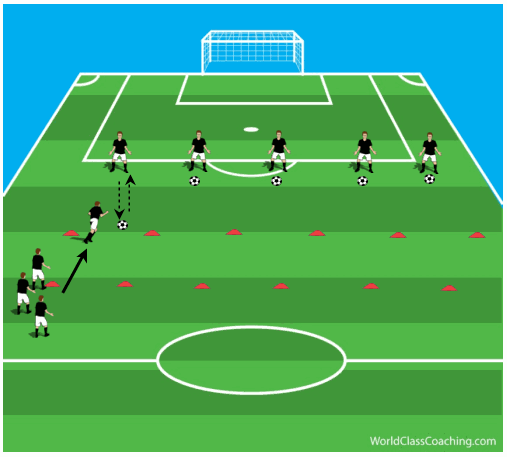
As soon as they return the pass, the player must rapidly backpedal until they reach the second cone in the top row of cones (Figure 3).
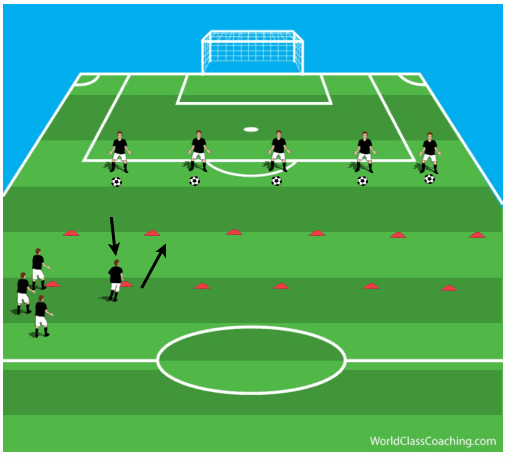
When they reach this cone, they must immediately sprint towards the second channel (space between cones 2 and 3 in the first row of cones) where they will receive a pass from the second player, which they again return with 2 touches (Figure 4).
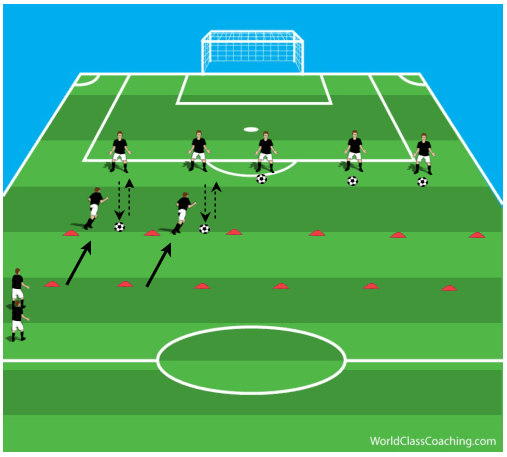
Have the player continue this sequence of sprint--receive and pass--backpedal. After the player receives and returns the pass in the 5th and final channel, they must backpedal and then sprint as quickly as possible to the starting cone (Figure 5).
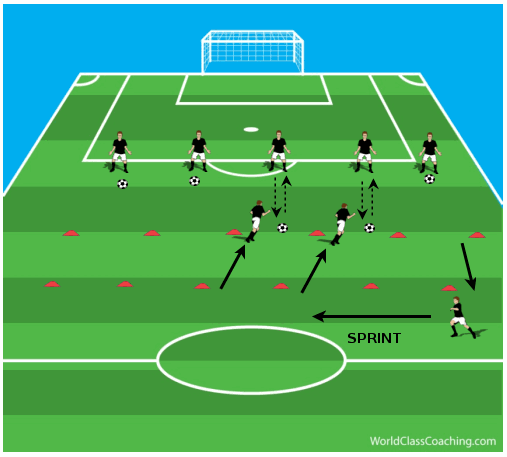
In order to keep the activity moving, the person next in line goes (and repeats the same process) as soon as the player in front of them returns the pass in the second channel (Figure 4 above).
Continue this process until each player has done 2 repetitions of the circuit. This should take no more than 90 seconds. Have the players rest for 60 seconds and then have the two groups switch roles. Ensure both groups do a total of 3 sets (2 repetitions of the circuit per set).
Coaching Points:
- This exercise is intended to be high in intensity so encourage your players to give a high work-rate during each set
- ood posture and a low centre of gravity must be maintained at all times
- The player must accelerate or attack the pass using rapid, powerful steps. However, as they player is just about to receive the pass, they should decelerate quickly by taking shorter steps
- After playing the pass, they must quickly transition to backpedaling by using the supporting leg (non-passing foot) to propel themselves backwards
- When backpedaling, the player must use small, quick steps while maintaining a low centre of gravity. The bodyweight should also be kept forward
- When passing, the player should be compact over the ball with the supporting leg placed beside the ball. Coach the weight and accuracy of the pass from both group of players
Best of Luck,
Justin
Justin Cresser – Has coached soccer at various levels both in North America and abroad (Hong Kong and Africa). His most recent position was as the Assistant Technical Director at the Soccer Club of Toronto. He has his National Diploma from the NSCAA and is also a certified strength and conditioning coach.


